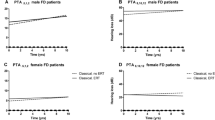Summary
Background: Hearing loss and tinnitus are common symptoms in Fabry disease and increase in prevalence with age. This study aimed to provide an epidemiological description of hearing impairment and tinnitus in children with Fabry disease in the Fabry Outcome Survey (FOS), an international database to assess the natural history of Fabry disease and the efficacy of enzyme replacement therapy with agalsidase alfa. Methods: Signs and symptoms questionnaires were completed for 543 children with Fabry disease. Pure-tone audiograms were obtained from 101 children (53 girls, 48 boys). Results: On questioning, 33% of the children (n = 179) reported subjective hearing impairment. However, when assessed by age-appropriate audiometry, only 19 of 101 patients (19%) had a persistent hearing loss at least one frequency. Of these, 14 had a high-frequency hearing loss, 4 a pan-frequency hearing loss, and 1 a pattern typical of noise-induced loss. Of the 101 children with audiometry, 44 complained of tinnitus. Only 2 children reported sudden hearing loss, which was not verified by audiometry. Children with tinnitus had greater disease severity scores. Conclusions: Hearing loss is a well-known clinical manifestation in patients with Fabry disease. It was reported in significant numbers of children in the FOS signs and symptoms questionnaire, but confirmed in only 19% by formal audiometry. The subjective hearing impairment may have been due to middle-ear effusions in many cases. Tinnitus is a well-recognized symptom in Fabry disease and can present in childhood. The presence of tinnitus correlated with overall disease severity.



Similar content being viewed by others
Abbreviations
- ERT:
-
enzyme replacement therapy
- FD:
-
Fabry disease
- FOS:
-
Fabry Outcome Survey
- FOS-MSSI:
-
Mainz Severity Score Index used in Fabry Outcome Survey
- ISO:
-
International Organization for Standardization
- PTA:
-
pure-tone average
- SD:
-
standard deviation
- WHO:
-
World Health Organization
References
Baguley DM, McFerran DJ (1999) Tinnitus in childhood. Int J Pediatr Otorhinolaryngol 49:99–105
Davidson J, Hyde ML, Alberti PW (1989) Epidemiologic patterns in childhood hearing loss: a review. Int J Pediatr Otorhinolaryngol 17:239–266
Fiellau-Nikolajsen M (1980) Tympanometry and middle ear effusion: a cohort-study in three-year-old children. Int J Pediatr Otorhinolaryngol 2:39–49
Germain DP, Avan P, Chassaing A, Bonfils P (2002) Patients affected with Fabry disease have an increased incidence of progressive hearing loss and sudden deafness: an investigation of twenty-two hemizygous male patients. BMC Med Genet 3:10
Hajioff D, Hegemann S, Conti G et al. (2006) Agalsidase alpha and hearing in Fabry disease: data from the Fabry Outcome Survey. Eur J Clin Invest 36:663–667
Hegemann S, Hajioff D, Conti G et al. (2006) Hearing loss in Fabry disease: data from the Fabry Outcome Survey. Eur J Clin Invest 36:654–662
Holgers KM (2003) Tinnitus in 7-year-old children. Eur J Pediatr 162:276–278
Holgers KM, Juul J (2006) The suffering of tinnitus in childhood and adolescence. Int J Audiol 45:267–272
Hughes GB, Freedman MA, Haberkamp TJ, Guay ME (1996) Sudden sensorineural hearing loss. Otolaryngol Clin North Am 29:393–405
ISO (1989) Acoustics – Audiometric test methods – Part 1: Basic pure tone air and bone conduction threshold audiometry. ISO 8253–1. Available online at: http://www.iso.org Accessed 21 Feb 2009
Keilmann A (2003) Inner ear function in children with Fabry disease. Acta Paediatr Suppl 92:31–32; discussion 27
Lee CA, Mistry D, Uppal S, Coatesworth AP (2005) Otologic side effects of drugs. J Laryngol Otol 119:267–271
Limberger A, Beck M, Delgado-Sanchez S, Keilmann A (2007) [Hearing loss in patients with Fabry disease]. HNO 55:185–189
Mehta A, Ricci R, Widmer U et al. (2004) Fabry disease defined: baseline clinical manifestations of 366 patients in the Fabry Outcome Survey. Eur J Clin Invest 34:236–242
Ramaswami U, Whybra C, Parini R et al. (2006) Clinical manifestations of Fabry disease in children: data from the Fabry Outcome Survey. Acta Paediatr 95:86–92
Ries M, Ramaswami U, Parini R et al. (2003) The early clinical phenotype of Fabry disease: a study on 35 European children and adolescents. Eur J Pediatr 162:767–772
Ries M, Kim HJ, Zalewski CK et al. (2007) Neuropathic and cerebrovascular correlates of hearing loss in Fabry disease. Brain 130:143–150
Savastano M (2007) Characteristics of tinnitus in childhood. Eur J Pediatr 166:797–801
Seifert E, Brosch S, Dinnesen AG et al. (2005) [Peripheral hearing disorders in childhood. Results of an evidenced based consensus conference]. HNO 53:376–382
WHO (1980) International classification of impairments, disabilities and handicaps: a manual of classification related to the consequences of disease. WHO, Geneva
Whybra C, Kampmann C, Krummenauer F et al. (2004) The Mainz Severity Score Index: a new instrument for quantifying the Anderson–Fabry disease phenotype, and the response of patients to enzyme replacement therapy. Clin Genet 65:299–307
Whybra C, Baehner F, Baron K (2006) Measurement of disease severity and progression in Fabry disease. In: Mehta A, Beck M, Sunder-Plassmann G (eds) Fabry disease: perspectives from 5 years of FOS. Oxford PharmaGenesis Ltd, Oxford, 315–322
Acknowledgements
All FOS investigators have submitted data from their patients to the FOS database. See www.globaloutcomesurveys.com for complete list. The FOS database is under the independent control of the FOS International Board. Data collection and analysis in FOS is supported by Shire Human Genetic Therapies (HGT), Danderyd, Sweden. The sponsor had no role in the interpretation of data or writing of this report. Authors received support for travel in relation to the material described in this manuscript from Shire HGT. Editorial assistance to the authors was provided by Ingrid Edsman, Edsman Medical Writing. Funding for editorial assistance was provided by Shire HGT.
Author information
Authors and Affiliations
Consortia
Corresponding author
Additional information
Communicating editor: Ed Wraith
Competing interests: None declared
References to electronic databases: Fabry disease: OMIM 301500.
Rights and permissions
About this article
Cite this article
Keilmann, A., Hajioff, D., Ramaswami, U. et al. Ear symptoms in children with Fabry disease: data from the Fabry Outcome Survey. J Inherit Metab Dis 32, 739–744 (2009). https://doi.org/10.1007/s10545-009-1290-x
Received:
Revised:
Accepted:
Published:
Issue Date:
DOI: https://doi.org/10.1007/s10545-009-1290-x




